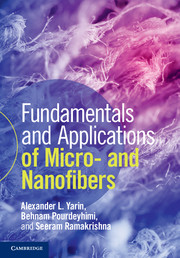Book contents
- Frontmatter
- Contents
- Preface
- 1 Introduction
- 2 Polymer physics and rheology
- 3 General quasi-one-dimensional equations of dynamics of free liquid jets, capillary and bending instability
- 4 Melt- and solution blowing
- 5 Electrospinning of micro- and nanofibers
- 6 Additional methods and materials used to form micro- and nanofibers
- 7 Tensile properties of micro- and nanofibers
- 8 Post-processing
- 9 Applications of micro- and nanofibers
- 10 Military applications of micro- and nanofibers
- 11 Applications of micro- and nanofibers, and micro- and nanoparticles: healthcare, nutrition, drug delivery and personal care
- Subject Index
- References
9 - Applications of micro- and nanofibers
Published online by Cambridge University Press: 05 June 2014
- Frontmatter
- Contents
- Preface
- 1 Introduction
- 2 Polymer physics and rheology
- 3 General quasi-one-dimensional equations of dynamics of free liquid jets, capillary and bending instability
- 4 Melt- and solution blowing
- 5 Electrospinning of micro- and nanofibers
- 6 Additional methods and materials used to form micro- and nanofibers
- 7 Tensile properties of micro- and nanofibers
- 8 Post-processing
- 9 Applications of micro- and nanofibers
- 10 Military applications of micro- and nanofibers
- 11 Applications of micro- and nanofibers, and micro- and nanoparticles: healthcare, nutrition, drug delivery and personal care
- Subject Index
- References
Summary
This chapter outlines several applications of electrospun and solution-blown nanofibers and their mats. In the case of filters and membranes (Section 9.1), industrial application has already begun, but a number of research questions are still open. Applications of nanofiber mats as fluffy electrodes beneficial for fuel cells and Li-ion batteries have recently attracted significant attention and are the focus of Section 9.2. Two recent approaches based on nanofibers were proposed in the field of cooling of high-heat flux microelectronics (Section 9.3) and nanofluidics (Section 9.4).
Filters and membranes
Filter materials are used for air, water and blood filtration, while membranes are used in separation processes, in particular, for bioseparation and pathogen removal for direct blood transfusion. Filters can remove particles, droplets, bacteria, viruses or even individual molecules from a carrier fluid flowing through them, or, in principle, possess advanced detection and response features that are practically absent in today’s products (see Chapter 10).
- Type
- Chapter
- Information
- Fundamentals and Applications of Micro- and Nanofibers , pp. 337 - 358Publisher: Cambridge University PressPrint publication year: 2014
References
- 1
- Cited by



